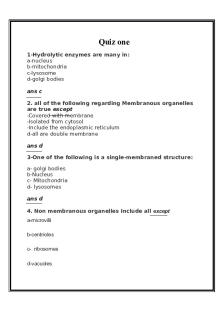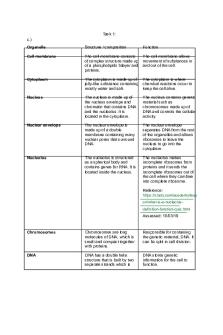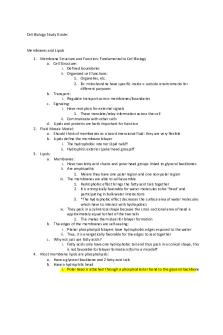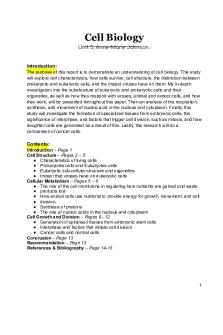Cell to cell communication -Cell Biology and Genetics- UPASS PDF

| Title | Cell to cell communication -Cell Biology and Genetics- UPASS |
|---|---|
| Course | Cell Biology and Genetics |
| Institution | University of Technology Sydney |
| Pages | 4 |
| File Size | 231.2 KB |
| File Type | |
| Total Downloads | 9 |
| Total Views | 166 |
Summary
Cell to cell review practice questions from UPass with answers...
Description
PIP2
Is a phospholipid in the plasma membrane that is cleaved to form two different second messengers IP3 Is a second messenger formed, along with DAG, when a phospholipid in the membrane is cleaved DAG Is a second messenger formed, along with IP3, when a phospholipid in the membrane is cleaved Camp Is a second messenger formed from ATP Cell signalling
When histamine binds to a histamine receptor, the specific cellular response that results is determined by the following factors:
the type of histamine receptor the type of cell in which the receptor is located the enzyme that is activated by the G protein associated with the receptor the types of second messengers involved in the signal transduction pathway the proteins activated by the second messengers
Signaling molecules can trigger a multitude of cellular responses, which may ultimately affect the transcription of genes, the activity of proteins, or cell growth and division. The cleavage of glycogen by glycogen phosphorylase releases _____. Epinephrine acts as a signal molecule that attaches to _____ proteins
Glucose-1-phosphate
Which if these is activated by calcium ions?
Calmodulin, is a calcium-binding protien.
G-protein-linked receptor
Kinases are enzymes that phosphorylate other molecules. Tyrosine-kinase receptors consist of two polypeptides that join when activated by a signal molecule. Phospholipase C catalyzes the formation of IP3. Ion channels are found on both the plasma membrane and the endoplasmic reticulum
Calcium binds to calmodulin A toxin that inhibits the production of GTP would interfere with the function of a signal transduction pathway that is initiated by the binding of a signal molecule to _____ receptors.
G-protein-linked
Steroid hormones are chemical signaling molecules. Because they are usually small and hydrophobic, steroid hormones can readily pass through a cell’s plasma membrane. The receptors for steroid hormones are usually located in the cytoplasm of target cells.
Both G protein-coupled receptors and receptor tyrosine kinases are transmembrane receptors that have a binding domain located on the extracellular side of the plasma membrane. The binding of a signaling molecule to these receptors is the first step in a signaling pathway. However, what happens after a signaling molecule binds is different for each receptor. An activated G protein-coupled receptor activates a G protein inside the cell, which involves the release of GDP and the binding of GTP. The activated G protein then activates an associated enzyme, leading to a cellular response. Receptor tyrosine kinases form dimers after binding signaling molecules. The tyrosines are then phosphorylated, fully activating the receptor. Each phosphorylated tyrosine can bind a relay protein, each of which can trigger a transduction pathway. In this way, a single signaling-molecule binding event can trigger multiple signal transduction pathways and thus multiple cellular responses.
When histamine encounters a target cell, it binds extracellularly to the H1 receptor, causing a change in the shape of the receptor. This change in shape allows the G protein to bind to the H1 receptor, causing a GTP molecule to displace a GDP molecule and activating the G protein. The active G protein dissociates from the H1 receptor and binds to the enzyme phospholipase C, activating it. The
active phospholipase C triggers a cellular response. The G protein then functions as a GTPase and hydrolyzes the GTP to GDP. The G protein dissociates from the enzyme and is inactive again and
ready for reuse....
Similar Free PDFs

Cell biology and genetics
- 12 Pages

Cell Communication
- 16 Pages

Cell Biology Quiz CELL ORGANELLES
- 10 Pages

Cell biology
- 3 Pages

Cell and molecular biology
- 16 Pages

Cell mitosis - cell mitotsis
- 4 Pages

Chapter 11 - Cell communication
- 12 Pages

Cell Biology Study Guide
- 37 Pages

Cell Biology unit (5)
- 14 Pages

Cell Biology Syllabus 2019
- 5 Pages

Apoptosis - Summary Cell Biology
- 4 Pages

Cell biology exam, answers
- 11 Pages

Cell biology lecture notes
- 108 Pages
Popular Institutions
- Tinajero National High School - Annex
- Politeknik Caltex Riau
- Yokohama City University
- SGT University
- University of Al-Qadisiyah
- Divine Word College of Vigan
- Techniek College Rotterdam
- Universidade de Santiago
- Universiti Teknologi MARA Cawangan Johor Kampus Pasir Gudang
- Poltekkes Kemenkes Yogyakarta
- Baguio City National High School
- Colegio san marcos
- preparatoria uno
- Centro de Bachillerato Tecnológico Industrial y de Servicios No. 107
- Dalian Maritime University
- Quang Trung Secondary School
- Colegio Tecnológico en Informática
- Corporación Regional de Educación Superior
- Grupo CEDVA
- Dar Al Uloom University
- Centro de Estudios Preuniversitarios de la Universidad Nacional de Ingeniería
- 上智大学
- Aakash International School, Nuna Majara
- San Felipe Neri Catholic School
- Kang Chiao International School - New Taipei City
- Misamis Occidental National High School
- Institución Educativa Escuela Normal Juan Ladrilleros
- Kolehiyo ng Pantukan
- Batanes State College
- Instituto Continental
- Sekolah Menengah Kejuruan Kesehatan Kaltara (Tarakan)
- Colegio de La Inmaculada Concepcion - Cebu


